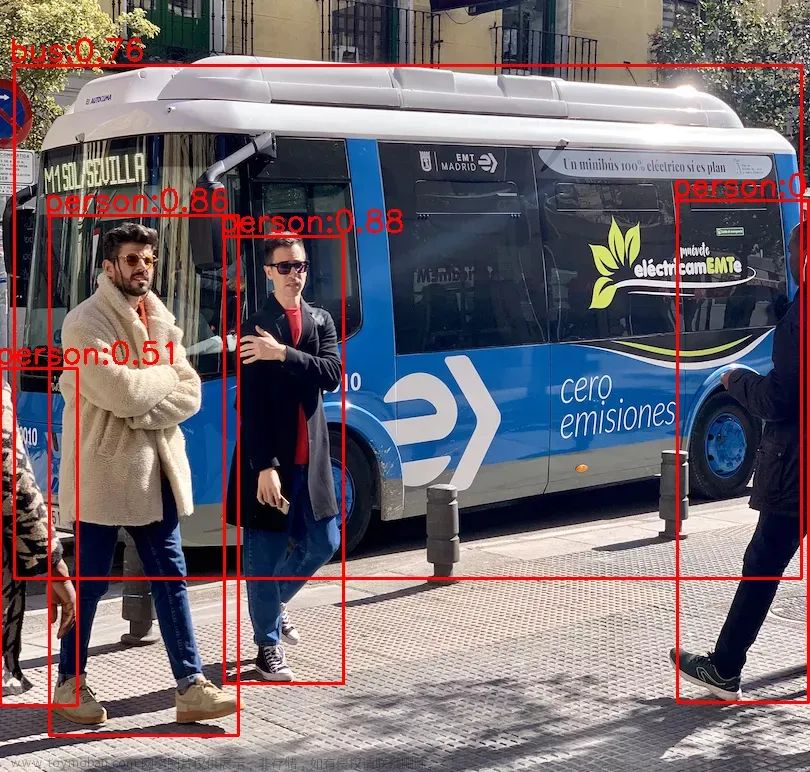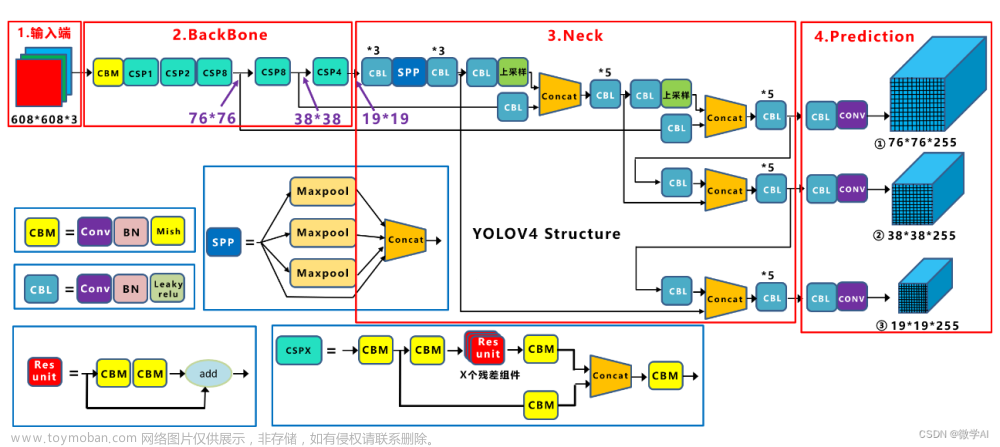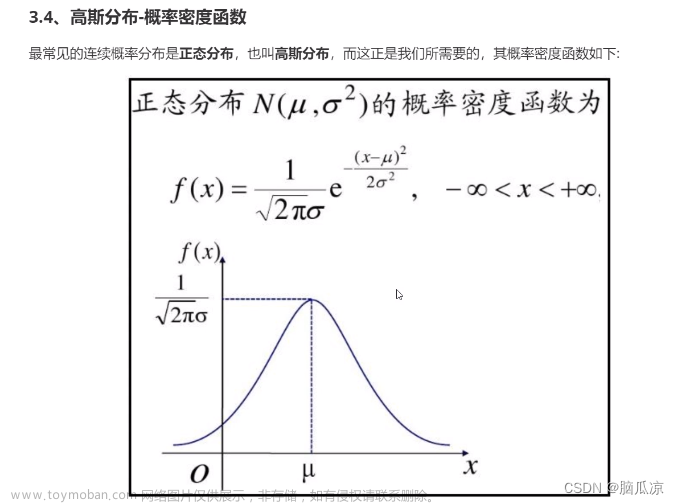本文章将结合代码对yolov5损失函数部分进行详细说明,包含其中的样本匹配问题。如果还需要学习关于yolov5其他部分内容,可以参考我其他文章。
yolov5语义分割:
yolov5图像分割中的NMS处理
yolov5图像分割Segmentation函数
yolov5 trt 学习:
yolov5 trt推理【python版】
yolov5剪枝:
yolov5剪枝
通过yaml修改yolov5:
通过yaml修改yolov5网络
iou样本匹配:
以yolov4 loss为例讲解iou样本匹配
NMS预测框的筛选
目录
ComputeLoss
样本匹配--build_targets函数
box_loss
cls_loss
obj_loss
下面的3个feature_map是仿照v5的head随机产生的输出。为了方便后面代码讲解,这里我设置的num_classes为1 。
feature_map1 = torch.rand([batch_size, 3, 80, 80, 5 + num_classes])
feature_map2 = torch.rand([batch_size, 3, 40, 40, 5 + num_classes])
feature_map3 = torch.rand([batch_size, 3, 20, 20, 5 + num_classes])
pred = [feature_map1, feature_map2, feature_map3]而标签target如下【也就是通过dataloader处理后的数据集】
我这里的target也是我随便举例的,可以看到他的shape为[3,6],也就是【num_obj, batch_idex+classes+xywh】。这里的num_obj表示当前图像中有出现了几个目标,batch_idex是第几个图像或者说第几个batch的索引,比如我这里batch是2,但这个是第一张图像的target信息,class表示当前目标是什么类【注意和num_classes区分】,后面的xywh就是box信息。
targets = torch.tensor([[0.00000, 0.00000, 0.04204, 0.21125, 0.08408, 0.36503],
[0.00000, 0.00000, 0.14960, 0.24400, 0.23867, 0.36503],
[0.00000, 0.00000, 0.36253, 0.24517, 0.21995, 0.39545]])ComputeLoss
下面这一部分是computeLoss定义的初始化参数。
yolo系列的损失函数通常为三个部分。cls_loss[分类],obj_loss[置信度loss],loc_loss[box loss].
前两者从代码中可以看到采用二分类交叉熵。【这里不说focalLoss】
self.balance可以理解为三个head部分的权重,即分配给小中大目标的权重[80*80head预测小目标,40*40预测中目标,20*20预测小目标]。
na:表示anchors的数量
nc:num_classes
nl:head的数量
class ComputeLoss:
sort_obj_iou = False
# Compute losses
def __init__(self, model, autobalance=False):
device = next(model.parameters()).device # get model device
h = model.hyp # 获取超参数
# 损失函数定义,cls:二分类交叉熵, obj:二分类交叉熵
BCEcls = nn.BCEWithLogitsLoss(pos_weight=torch.tensor([h['cls_pw']], device=device))
BCEobj = nn.BCEWithLogitsLoss(pos_weight=torch.tensor([h['obj_pw']], device=device))
# Class label smoothing https://arxiv.org/pdf/1902.04103.pdf eqn 3
self.cp, self.cn = smooth_BCE(eps=h.get('label_smoothing', 0.0)) # positive, negative BCE targets
# Focal loss
g = h['fl_gamma'] # focal loss gamma
if g > 0:
BCEcls, BCEobj = FocalLoss(BCEcls, g), FocalLoss(BCEobj, g)
m = de_parallel(model).model[-1] # Detect() module
# balance用于判断是否输出为3层,如果是返回[4.0, 1.0, 0.4], 否则返回[4, 1, 0.25, 0.06, 0.02] 这些value值是给小中大目标Head给的权重
self.balance = {3: [4.0, 1.0, 0.4]}.get(m.nl, [4.0, 1.0, 0.25, 0.06, 0.02]) # P3-P7
self.ssi = list(m.stride).index(16) if autobalance else 0 # stride 16 index 返回步长为16的索引
self.BCEcls, self.BCEobj, self.gr, self.hyp, self.autobalance = BCEcls, BCEobj, 1.0, h, autobalance
self.na = m.na # number of anchors
self.nc = m.nc # number of classes
self.nl = m.nl # number of layers
self.anchors = m.anchors
self.device = device样本匹配--build_targets函数
样本的匹配需要看build_targets函数。函数中的p是三个预测层,targets数据集的真实值。
tcls,tbox,indices,anch是用来存放匹配结果。
gain是用来后面target缩放到特征层上。
def build_targets(self, p, targets):
# Build targets for compute_loss(), input targets(image,class,x,y,w,h)
na, nt = self.na, targets.shape[0] # number of anchors, targets. anchor数量, target数量
tcls, tbox, indices, anch = [], [], [], []
gain = torch.ones(7, device=self.device) # normalized to gridspace gainai可以理解为anchor的索引,我们知道yolov5有3个head,每个head上3种anchor,因此这里就相当于给每个head上的anchor编号为0,1,2.通过view将其以列的形式排列,利用repeat函数复制nt列[这里的nt就是target中的目标数].
ai = torch.arange(na, device=self.device).float().view(na, 1).repeat(1, nt)
ai tensor([[0., 0., 0.],
[1., 1., 1.],
[2., 2., 2.],
...,
])
行数等于target数量,shape is [target[0], 1]
通过将targets和前面的ai进行cat拼接操作,那么就可以相当于给每个目标都分配了anchor的索引。
targets = torch.cat((targets.repeat(na, 1, 1), ai[..., None]), 2) # append anchor indices可以看到给target中的三个目标均分配了0,1,2的索引【后面会利用这个索引来具体看样本和哪个anchor是匹配的】
给每个target分配anchor索引
tensor([[[0.00000, 0.00000, 0.04204, 0.21125, 0.08408, 0.36503, 0.00000],
[0.00000, 0.00000, 0.14960, 0.24400, 0.23867, 0.36503, 0.00000],
[0.00000, 0.00000, 0.36253, 0.24517, 0.21995, 0.39545, 0.00000]],[ [0.00000, 0.00000, 0.04204, 0.21125, 0.08408, 0.36503, 1.00000],
[0.00000, 0.00000, 0.14960, 0.24400, 0.23867, 0.36503, 1.00000],
[0.00000, 0.00000, 0.36253, 0.24517, 0.21995, 0.39545, 1.00000]],[ [0.00000, 0.00000, 0.04204, 0.21125, 0.08408, 0.36503, 2.00000],
[0.00000, 0.00000, 0.14960, 0.24400, 0.23867, 0.36503, 2.00000],
[0.00000, 0.00000, 0.36253, 0.24517, 0.21995, 0.39545, 2.00000]]])
targets:[num_obj, 6],repeat(3,1,1)表示复制3个1行1列,则repeat后 targets shape变为[3,num_obj,6]ai = [[[0.], [0.], [0.]..] [[1.], [1.], [1.]...] [[2.], [2.] [2.]...]] ai[...,None] shape [3, num_obj, 1] cat后targets shape [3, num_obj,6+1]=[3,num_obj,7] 也就是targets[...,:6]保存的是targets信息,targets[...,6:]保存的是对于anchors索引
接下来是遍历三个head进行target和anchor的匹配来确定正样本。
比如在遍历第一个head的时候shape为【batch,3,80,80,5+num_classes】.
那么此时的gain通过下面操作将变为【1,1,80,80,80,80,1】。
for i in range(self.nl):
anchors, shape = self.anchors[i], p[i].shape
# torch.tensor(shape)=[batch,3,80,80,85]
gain[2:6] = torch.tensor(shape)[[3, 2, 3, 2]] # xyxy gain 获取特征层的w和h[80,80,80,80]大家可以回看target中的box信息,可以看到这些最初的box信息值范围是0~1的,但此时我们的特征层head w和h是80*80,这肯定是不匹配的,所以可以通过targets * gain将这些Box缩放到特征层上得到真实的尺寸。
# Match targets to anchors 先验框和target框的匹配
t = targets * gain # shape(3,n,7) 将targets中的box缩放到特征层上那么此时得到的t如下。可以看到box信息缩放到80*80特征层上具体是多少了。
tensor([[[ 0.00000, 0.00000, 3.36320, 16.90000, 6.72640, 29.20240, 0.00000],
[ 0.00000, 0.00000, 11.96800, 19.52000, 19.09360, 29.20240, 0.00000],
[ 0.00000, 0.00000, 29.00240, 19.61360, 17.59600, 31.63600, 0.00000]],[[ 0.00000, 0.00000, 3.36320, 16.90000, 6.72640, 29.20240, 1.00000],
[ 0.00000, 0.00000, 11.96800, 19.52000, 19.09360, 29.20240, 1.00000],
[ 0.00000, 0.00000, 29.00240, 19.61360, 17.59600, 31.63600, 1.00000]],[[ 0.00000, 0.00000, 3.36320, 16.90000, 6.72640, 29.20240, 2.00000],
[ 0.00000, 0.00000, 11.96800, 19.52000, 19.09360, 29.20240, 2.00000],
[ 0.00000, 0.00000, 29.00240, 19.61360, 17.59600, 31.63600, 2.00000]]])
yolov5中的样本匹配与之前yolov4或者SSD的样本匹配不同,yolov5采用的是宽高比例的匹配策略,不同于iou匹配。
具体做法是:(1)target的宽高与anchor的宽高比得到ratio1【对应代码中的r】
(2)anchor的宽高与target的宽高比得到ratio1【对应代码中的1/r】
(3)取上面两个比值的最大值与阈值比较【默认为4对应代码中anchor_t】,如果小于该阈值那么认为匹配成功。
r = t[..., 4:6] / anchors[:, None] # wh ratio
j = torch.max(r, 1 / r).max(2)[0] < self.hyp['anchor_t'] # compare此时得到的j【也就是和阈值相比较】均为False,就是表示没有匹配成功,也就是可以认为,此时的target中所有的目标不能被80*80的head所预测【或者说这些目标中没有小目标】
tensor([[False, False, False],
[False, False, False],
[False, False, False]])
当遍历到第二个head,也就是大小为40*40的head上时。target也需要缩放到40*40上面,此时为:
tensor([[[ 0.00000, 0.00000, 1.68160, 8.45000, 3.36320, 14.60120, 0.00000],
[ 0.00000, 0.00000, 5.98400, 9.76000, 9.54680, 14.60120, 0.00000],
[ 0.00000, 0.00000, 14.50120, 9.80680, 8.79800, 15.81800, 0.00000]],[ [ 0.00000, 0.00000, 1.68160, 8.45000, 3.36320, 14.60120, 1.00000],
[ 0.00000, 0.00000, 5.98400, 9.76000, 9.54680, 14.60120, 1.00000],
[ 0.00000, 0.00000, 14.50120, 9.80680, 8.79800, 15.81800, 1.00000]],[ [ 0.00000, 0.00000, 1.68160, 8.45000, 3.36320, 14.60120, 2.00000],
[ 0.00000, 0.00000, 5.98400, 9.76000, 9.54680, 14.60120, 2.00000],
[ 0.00000, 0.00000, 14.50120, 9.80680, 8.79800, 15.81800, 2.00000]]])
此时通过宽高比阈值筛选得到:也就是可以知道target中目标可以被40*40这个head的第0与第2号anchor所匹配,这些anchor所匹配的样本就是我们要的正样本GT.
tensor([[ True, False, False],
[False, False, False],
[ True, True, True]])
通过上面的mask过滤一下targets.
tensor([[ 0.00000, 0.00000, 1.68160, 8.45000, 3.36320, 14.60120, 0.00000],
[ 0.00000, 0.00000, 1.68160, 8.45000, 3.36320, 14.60120, 2.00000],
[ 0.00000, 0.00000, 5.98400, 9.76000, 9.54680, 14.60120, 2.00000],
[ 0.00000, 0.00000, 14.50120, 9.80680, 8.79800, 15.81800, 2.00000]])
得到过滤后目标的中心点坐标
gxy = t[:, 2:4] # grid xy得到中心点相对于边界的距离
gxi = gain[[2, 3]] - gxyjk和lm是判断gxy的中心点更偏向哪里.
j, k = ((gxy % 1 < g) & (gxy > 1)).T
l, m = ((gxi % 1 < g) & (gxi > 1)).T
j = torch.stack((torch.ones_like(j), j, k, l, m))得到的j如下,包含当前网格有五个cell,第一行保留所有的gtbox,第二行表示左边的cell中的gt,第三行是表示上方的cell中的gt,第四行是右边cell的网格,第五行是下方的cell中的gt。这里与v3和v4不同在于之前的yolo是目标落在哪个head的cell就由该cell进行预测,而v5通过增加邻近的cell来预测,这样就是相当于增加了正样本的数量。
tensor([[ True, True, True, True],
[False, False, False, False],
[ True, True, False, False],
[ True, True, True, True],
[False, False, True, True]])
在yolov5中不仅仅用了中心点进行预测,还采用了距离中心点网格最近的两个网格,所以是有五种情况【四周的网格和当前中心的网格】同时用上面的j过滤,这样就可以得出哪些网格有目标
t = t.repeat((5, 1, 1))[j]
offsets = (torch.zeros_like(gxy)[None] + off[:, None])[j] def build_targets(self, p, targets):
# Build targets for compute_loss(), input targets(image,class,x,y,w,h)
na, nt = self.na, targets.shape[0] # number of anchors, targets. anchor数量, target数量
tcls, tbox, indices, anch = [], [], [], []
gain = torch.ones(7, device=self.device) # normalized to gridspace gain
'''
ai tensor([[0., 0., 0.],
[1., 1., 1.],
[2., 2., 2.],
...,
])
行数等于target数量,shape is [target[0], 1]
'''
ai = torch.arange(na, device=self.device).float().view(na, 1).repeat(1, nt) # same as .repeat_interleave(nt)
'''
targets:[num_obj, 6],repeat(3,1,1)表示复制3个1行1列,则repeat后 targets shape变为[3,num_obj,6]
ai = [[[0.],
[0.],
[0.]..]
[[1.],
[1.],
[1.]...]
[[2.],
[2.]
[2.]...]]
ai[...,None] shape [3, num_obj, 1]
cat后targets shape [3, num_obj,6+1]=[3,num_obj,7]
也就是targets[...,:6]保存的是targets信息,targets[...,6:]保存的是对于anchors索引
'''
targets = torch.cat((targets.repeat(na, 1, 1), ai[..., None]), 2) # append anchor indices
g = 0.5 # bias
off = torch.tensor(
[
[0, 0],
[1, 0],
[0, 1],
[-1, 0],
[0, -1], # j,k,l,m
# [1, 1], [1, -1], [-1, 1], [-1, -1], # jk,jm,lk,lm
],
device=self.device).float() * g # offsets
for i in range(self.nl):
anchors, shape = self.anchors[i], p[i].shape
# torch.tensor(shape)=[batch,3,80,80,85]
gain[2:6] = torch.tensor(shape)[[3, 2, 3, 2]] # xyxy gain 获取特征层的w和h[80,80,80,80]
# Match targets to anchors 先验框和target框的匹配
t = targets * gain # shape(3,n,7) 将targets中的box缩放到特征层上
if nt:
# Matches
'''
yolov5采用宽高比例的匹配策略,不同于iou匹配。
target的宽高与anchors宽高对应相除得到ratio1
anchors与target的宽高相处得到ratio2[也就是代码中的1/r]
取两个ratio最大值作为最后的宽高比,该宽高比和设定的阈值(默认为4[anchor_t])比较,小于该阈值的anchor则为匹配到的anchor
'''
r = t[..., 4:6] / anchors[:, None] # wh ratio
j = torch.max(r, 1 / r).max(2)[0] < self.hyp['anchor_t'] # compare
# j = wh_iou(anchors, t[:, 4:6]) > model.hyp['iou_t'] # iou(3,n)=wh_iou(anchors(3,2), gwh(n,2))
t = t[j] # filter
# Offsets
gxy = t[:, 2:4] # grid xy
gxi = gain[[2, 3]] - gxy # inverse
j, k = ((gxy % 1 < g) & (gxy > 1)).T
l, m = ((gxi % 1 < g) & (gxi > 1)).T
j = torch.stack((torch.ones_like(j), j, k, l, m))
t = t.repeat((5, 1, 1))[j]
offsets = (torch.zeros_like(gxy)[None] + off[:, None])[j]
else:
t = targets[0]
offsets = 0
# Define
bc, gxy, gwh, a = t.chunk(4, 1) # (image, class), grid xy, grid wh, anchors
a, (b, c) = a.long().view(-1), bc.long().T # anchors, image, class
gij = (gxy - offsets).long()
gi, gj = gij.T # grid indices
# Append
indices.append((b, a, gj.clamp_(0, shape[2] - 1), gi.clamp_(0, shape[3] - 1))) # image, anchor, grid
tbox.append(torch.cat((gxy - gij, gwh), 1)) # box
anch.append(anchors[a]) # anchors
tcls.append(c) # class
return tcls, tbox, indices, anch通过上面的样本匹配操作我们会得到4个值。
tcls:存储target中的类别,tbox:gt中的box信息,indices:当前gtbox属于第几张图像,gtbox与anchor的对应关系以及所属的cell坐标。anchors:anchor信息
获得b:图像;a:anchor, gj:gi Cell的纵坐标与横坐标
b, a, gj, gi = indices[i]tobj是用来后面存储gt中的目标信息,shape[batch_size,3, 80,80]
tobj = torch.zeros(pi.shape[:4], dtype=pi.dtype, device=self.device)如果目标存在,获取当前head所预测的中心坐标pxy,pwh,以及类置信度
pxy, pwh, _, pcls = pi[b, a, gj, gi].split((2, 2, 1, self.nc), 1) # target-subset of predictionsbox_loss
利用iou获取box_loss。
# Regression
pxy = pxy.sigmoid() * 2 - 0.5
pwh = (pwh.sigmoid() * 2) ** 2 * anchors[i]
pbox = torch.cat((pxy, pwh), 1) # predicted box
iou = bbox_iou(pbox, tbox[i], CIoU=True).squeeze() # iou(prediction, target)
lbox += (1.0 - iou).mean() # iou losscls_loss
if self.nc > 1: # cls loss (only if multiple classes)
t = torch.full_like(pcls, self.cn, device=self.device) # targets
t[range(n), tcls[i]] = self.cp
lcls += self.BCEcls(pcls, t) # BCEobj_loss
pi是指当前head层,pi[...,4]即取出conf这一维度与tobj做交叉熵。
obji = self.BCEobj(pi[..., 4], tobj)再与所对应的权重相乘,得到obj_loss
lobj += obji * self.balance[i]最后返回Loss 文章来源:https://www.toymoban.com/news/detail-785933.html
lbox *= self.hyp['box']
lobj *= self.hyp['obj']
lcls *= self.hyp['cls']
bs = tobj.shape[0] # batch size
return (lbox + lobj + lcls) * bs, torch.cat((lbox, lobj, lcls)).detach()loss: tensor([10.73431]) loss_item: tensor([0.06105, 5.30610, 0.00000]) 文章来源地址https://www.toymoban.com/news/detail-785933.html
到了这里,关于yolov5损失函数详解【附代码】的文章就介绍完了。如果您还想了解更多内容,请在右上角搜索TOY模板网以前的文章或继续浏览下面的相关文章,希望大家以后多多支持TOY模板网!













